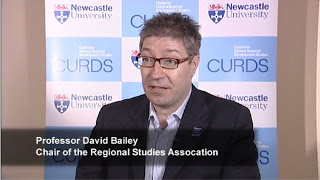August is a quiet month here at RSA blog HQ so David Bailey, Regional Studies Association Chair, has stepped up and provided us with some great twitter tips. Don’t forget to tweet David after reading this!
Many of us use social media and blogging as a way of making academic research in regional studies more accessible and to keep in touch with others in the field. The RSA has embraced this and has a very active social media presence (e.g. @RSA_learned on twitter) as well as this blog, for example. In our experience, it’s a great way to network.
In my own case I follow quite a few researchers, policy makers and politicians who I may never get the chance to meet. And like me, many of them use Facebook, LinkedIn, and Twitter to do what I do – to share links, to make connections, to ask for views, and to have a conversation. This has helped me connect with lots of people interested in things I’m interested in, whether it’s regional policy, the auto industry or something more personal like my favourite football team (#wba).
In my case I stumbled into using Twitter on the suggestion of a newspaper editor and soon found it a good way of highlighting what I was doing – whether a new blog, a report just out, a presentation at a conference, an interview on the TV or radio – or as a way of highlighting what others were doing.
In so doing, I didn’t really think about how to use Twitter ‘strategically’ to further my career or enhance my ‘impact. But that’s well worth thinking about, and for an excellent short guide go to ‘Top Twitter Tips for Academics’.
But if you’re just starting out, here are a few basic tips for using Twitter in your academic career…
1. Make sure you ‘brand yourself’ by linking all your online spaces to one name. It sounds obvious, but someone else may have already ‘grabbed’ your exact name as their Twitter handle or username, so in that case make sure that the Display name is the name you’re using for your professional identity.
2. Find others in your field. Just like when you read an interesting paper and follow up on references, do the same through Twitter. Look for academics or practitioners in the field you’re working in and see who they follow and who follows them (graduate students and early career researchers in particular are often very active and well informed tweeters). For example, see who follows @RSA_learned and who it follows. I’ve made lots of good connections that way.
3. Start discussions with the people you connect with. Tweet about what you’re doing, what you’re reading, what events you’re attending, and what’s going on in the area you’re researching.
4. Use hashtags, such as conference hashtags (when you see # before a word, that means it’s a hashtag). Conference organisers increasingly specify these, sometimes in advance of a conference. The latter can sometimes be helpful in interacting with people even before the event. Using this ‘twitter backchannel’ can be useful to find out about the highlights of parallel sessions you couldn’t get to, and what new themes are emerging at the conference.
5. Use Twitter for ‘real’ networking as well. ‘Hi I’m Regional Whispers’ (or whatever your username is) may be an easy way to say hello to someone you’ve been in contact with on Twitter but haven’t physically met before. In so doing, you may find it easier to strike up a conversation at an event and help in your networking.
6. Last but not least, think about how to use Twitter in interactions with students and departmental colleagues. For example, I often tweet interesting links that students can use, or answer short questions via Twitter, or try to keep conversations going after seminars have ended.
Note: David Bailey is the Chair of the Regional Studies Association, Professor of International Business Strategy and Economics at Coventry University Business School and prolific social media user. He blogs for the UK’s Birmingham post, regularly features as an expert commentator on the BBC and other media outlets, and can be reached on twitter via @dgbailey. Go on, tweet him!
